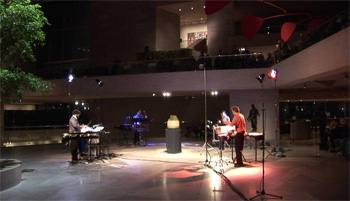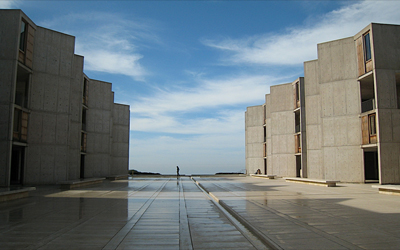Calit2 Composer in Residence Finds 'Sanctuary' at the Iconic Salk Institute
San Diego, Sept. 16, 2008 -- Following a critically acclaimed premiere last fall at the National Gallery of Art in Washington, D.C., the epic work "Sanctuary" by Roger Reynolds, Calit2's composer in residence at UC San Diego, receives its West Coast premiere on Saturday, Oct. 11, 6:30 p.m., in the courtyard of the Salk Institute for Biological Studies in La Jolla. The performance will be preceded by a discussion with the composer and performers in the Salk auditorium.
|
The Washington Post described the Pulitzer Prize winner's composition as "a once-in-a-lifetime aural experience" featuring "waves of gorgeous, purposeful, minutely detailed sound."
"Sanctuary" opens the 2008-09 season for UCSD's ArtPower! performance series as part of an increased schedule of experimental performance at venues including The Loft, the intimate new campus hot spot for edgy performances.
Tickets are $25 and available online at 858.534.TIXS or at www.artpower.ucsd.edu. Prior to the performance, a 4 p.m. tour of the Salk Institute will give visitors an inside look at architect Louis I. Kahn's modernist masterpiece
Reynolds is collaborating on "Sanctuary" with engineers, computer scientists and music technology professors. He is a member of UCSD's music faculty as well as composer-in-residence in the UCSD division of Calit2, which is co-producing the concert in the Salk Institute courtyard together with ArtPower! and UCSD Department of Music.
With "Sanctuary," Reynolds says he is exploring the nature of communication -- from primal utterance to song. This theme finds expression in undulating ups and downs of "proto-melodies and novel sonorities" that develop throughout the piece.
|
"A sanctuary can be a refuge, an asylum, a shelter from violence or the penalties of law," Reynolds says in a program note. "The idea has deep roots in many cultures. Ancient Greek temples offered sanctuary, and the Temple of Apollo at Delphi, with its Oracle, was known throughout the Mediterranean world. 'Sanctuary' continued through the Roman Empire and into the Christian era. It is occasionally invoked today around the globe, with recent examples in areas of sectarian strife and immigration law challenges.
"However, there is another powerful dimension of 'sanctuary' beyond protection: as a place of tolerance and privilege. In this sense, sanctuary is a place safe for expression, for experimentation, for revelation. Privilege also involves license: license to define boundaries, to test them. My project creates a place of refuge for the quartet, technicians and audience, and invites them to act on the privilege and the license so created--to reveal themselves and, in turn, to be revealed, perhaps transformed."
|
"It occurred to us that we were not only making sketches towards a new work, but were in fact diagramming the brief but volatile history of percussion as a serious medium in the canon of Western composition," Schick recalls. "We needed sonic diversity, so we drew composite installations of multiple small instruments. Our discussion began to include the sculpture of instrument design and the choreography of performance. Finally, there was the word that has become a part of almost every encounter and conversation I have with Roger: impact."
In the case of "Sanctuary," according to Schick, impact is realized not only through staging and sound, but through the movements of percussionists "striking, or rubbing, or buffeting sonorous objects" such as wood blocks, cowbells, bongos and found objects including bottles and bowls.
At the heart of "Sanctuary" is the second of three movements, "Oracle," in which an object chosen by the performers becomes a muse to whom the percussionists pose "questions" in the form of percussive patterns. In this case, the object of percussive attack and reverence is a large metal cylinder removed from an old clothes dryer with metal rods welded onto it.
Along with the ancient notion of an Oracle, "Sanctuary" ventures into the future with its use of technology. During the performance, Schick's hands are wired with sensors that send his rhythms to a laptop computer. The sound is then processed through audio software created by UCSD music faculty's Miller Puckette, and the results accompany and interact with the performers, or are inserted later in the performance.
Reynolds has long been fascinated with intersections of innovative music and architecture, art forms where he sees parallels. He has composed works for Kenzo Tange's Olympic Gymnasium in Tokyo, and Frank Loyd Wright's Guggenheim Museum in New York.
"Sanctuary" at Salk continues this interest. The building, designed by architect Louis I. Kahn, is considered a masterpiece of modern architecture. Its centerpiece is a wide courtyard that frames the ocean view, with a narrow channel of water through the center leading the eye toward the horizon. Admirers say the building has a mystical aura as materials and forms change their appearance depending on light, weather and seasons.
Reynolds admires the late Greek composer Iannis Xenakis, who began his career in the office of famed French architect Le Corbusier. Xenakis took a lead designing the Philips Pavilion for the 1958 World's Fair in Brussels. The Pavilion combined exhilarating architecture based on a form known as a hyperbolic paraboloid, with experimental film, and music by composer Edgard Varese.
Reynolds was good friends with Xenakis, and he invited Xenakis to UCSD in the 1980s to work with grad-level composers and performers. Reynolds and his wife Karen are working on a book about Xenakis' architecture. Xenakis even designed a home for the Reynolds for a California desert site. This house was never built due to cost considerations.
Before becoming a composer, Reynolds earned a degree in engineering from the University of Michigan, and in his scores, one can see his interest in structures. The scores often take the form of diagrams that represent the music in fascinating graphic forms.
"I'm known as a composer of music, but this role has a very broad significance for me. I use sounds to respond to and to explore the world around us: potentially any sound in any space. Clearly, it's not just orchestras and concert halls that will determine the future of our music," Reynolds says.
-----
Principals:
Roger Reynolds, Composer (UCSD Music)
Steven Schick, Percussionist (UCSD Music)
Miller Puckette, Designer, Max and PD software environments (UCSD Music)
Ian Saxton, Project Programmer (UCSD Music graduate)
Current Members of red fish blue fish (UCSD Music, see note below)
Greg Stuart (UCSD Music)
Justin DeHart (UCSD Music)
Ross Karre (UCSD Music)
Fabio Oliveira (UCSD Music)
Former Member-participants: Rob Esler, Gustavo Aguilar, Don Nichols, Mathias Reumert
Josef Kucera, Recording and Sound Engineer (UCSD Music)
Trevor Henthorn, Systems Manager (UCSD Music)
David Curry, Consultation and Web Design (David Curry & Associates) (http://sanctuaryproject.net)
Pei Xiang, Qualcomm Engineer (Computer Music Research, Ph.D. graduate, UCSD Music)
Jacob Sudol (Composition Program, UCSD Music)
Center for Research in Computing and the Arts (CRCA), technical and logistical support
UCSD Department of Music, technical and logistical support
Tickets Information:
Performance: $25
UCSD Faculty/Staff: $23
Student Admission: $10
ArtTalk! Free admission
The Salk Institute Tour: $10
Purchase at the UCSD Box Office
By Phone: 858.534.TIXS
Online: www.artpower.ucsd.edu
In Person: the UCSD Box Office, located in the Price Center Plaza
More information: www.artpower.ucsd.edu
Related Links
Sanctuary Project
ArtPower!
UCSD Department of Music
Media Contacts
Dirk Sutro, UCSD Music, dsutro@ucsd.edu
Doug Ramsey, Calit2, dramsey@ucsd.edu, 858-822-5825
Amy Thomas, ArtPower!, athomas@ucsd.edu



